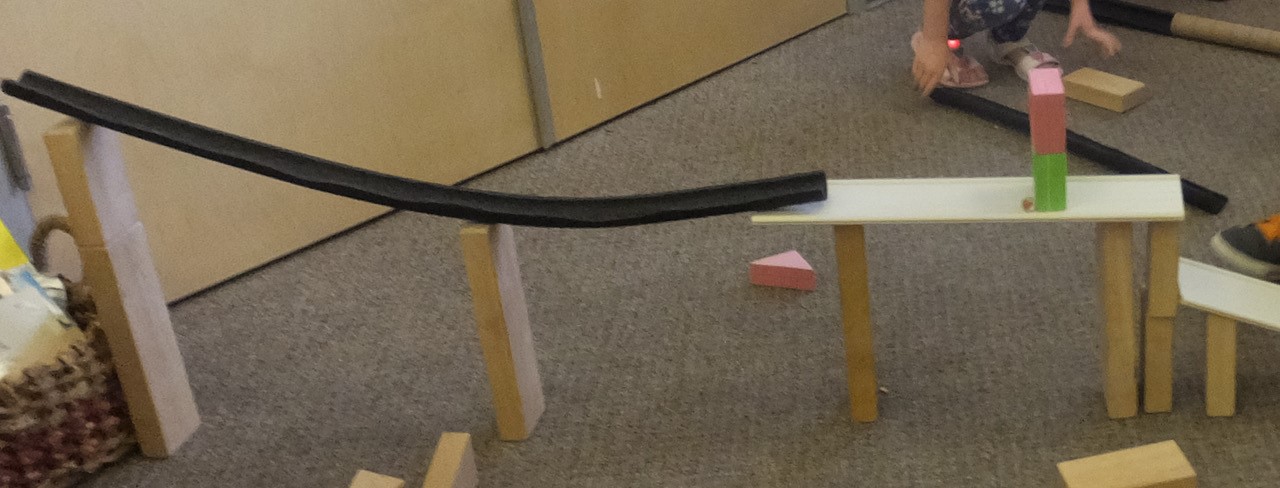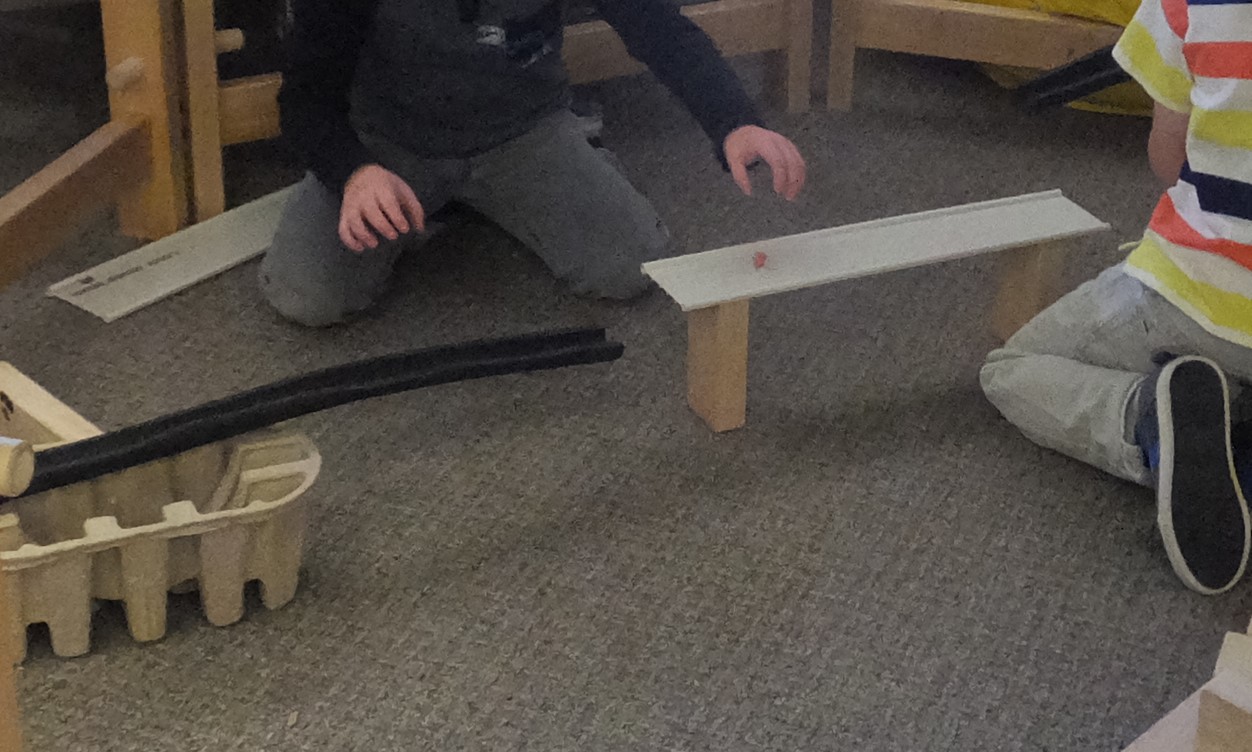The Early Years
Yes, Engineering in Preschool!
MATERIALS
- Ramp material (e.g., cardboard tubes, boards, foam pipe insulation, cove molding)
- Objects for rolling (lids, marbles, Ping Pong balls)
- Blocks of any kind (foam, wood, boxes)
- Documentation materials (drawing materials, camera)
- Internet, to share images and discuss work if school is meeting virtually
SAFETY
- Eye protection is required during this activity.
Preschoolers are natural engineers, constantly revising their ideas for buildings, games, and imaginative play and repeating activities, reinforcing learning. Programs such as Engineering is Elementary (EiE) noticed this and designed an Engineering Design Process (EDP) Infographic for Preschoolers—a three step “Explore – Create – Improve” Cycle, which works well with the Next Generation Science Standards science and engineering practices (NGSS Lead States 2013). I wondered how young children’s work would be different when their attention was focused on their actions, relating them back to an EDP. Would they spend more time improving their designs? Would they collaborate with peers and use evidence from previous marble runs? If I narrated their actions, would they recognize them as being part of an EDP? I posted the EiE Engineering Design Process sign, made question prompts, readied my narrative voice and waited.
I didn’t have to wait long. As my students were learning Hebrew shape words, they began noticing shapes in the classroom, including circles, called “igools” in Hebrew, and describing the properties of circles. I brought in recycled lids with all different diameters, rim depths, and materials, which inspired exploration of motion, leading to a six-month-long investigation into motion on ramps and ramp design. Throughout this project, I used narration to draw students’ attention to different parts of the posted Engineering Design Process graphic, especially the create and improve parts, often supplemented by directly referencing and pointing to the applicable part of their ramp.

This setup was designed to see if a marble could knock over blocks after running down a foam ramp.
Ramps and Marbles
Objective
- Design and build a marble run that uses a moving marble to push a block
- Provide students with materials for open-ended exploration of building and re-designing ramps for marbles (or larger spheres if ramp widths can accommodate them). Model accepting failure of your own design as a useful and sometimes necessary step toward re-design and new trials of marble motion.
- Use prompting language to encourage students to try various materials and ideas, using the explore part of the EDP, but resist telling them how to make a “good” ramp.
- Provide time to use materials and document success and failure of different ramp designs.
- Initiate discussion and reflection on ramp design (create) and re-design (improve). Discussions support many of the NGSS Practices, including asking questions and defining problems; analyzing and interpreting data; constructing explanations and designing solutions; engaging in argument from evidence; and obtaining, evaluating, and communicating information.
- If students do not create a ramp design that includes knocking over a block with moving marbles, model a simple design with a block at the lower end of your inclined ramp. Ask, “Can the marble move the block?”
Building and re-designing marble runs is an excellent activity to discuss variables with children. My students always liked varying the elevation of the marble run first, but as they become more proficient at building stable ramps, they alternated varying the elevation and the weight of the target blocks to achieve their goal of moving a block with a moving marble.
After students have some open exploration experience with building and redesigning marble runs, encourage them to test variables such as ramp height and ramp length to see if making changes in these variables will affect whether the marble can move the block at the bottom of the ramp.
Students explored how the lids moved, rolling them across the floor and experimenting using different amounts of force, noticing that too much force pushed the lids down flat. Questions came up, such as, “Why did some lids fall on one side and some roll better than others?” While rolling the lids on different surfaces—carpet, cardboard, plastics, and blocks—students observed different speeds. They also noticed lids went faster when one end of the surface was higher, forming a slope, leading to exploring ramp design.
Because lids often fell over, students decided to change the ramp material. Students came up with and tested a list of ramp requirements. Foam pipe insulation, cut in half lengthwise, seemed to work best. But lids still fell over regularly! After discussion and interviewing family about possible lid substitutes, the students decided to use marbles.
Students’ ramp explorations continued until the school year ended. They spent hours building complex elevated arrangements with specific purposes in mind, challenging themselves with turnings at right angles, jumping tracks, spiraling down, and creating discontinuous marble runs. Students began to write notes, draw diagrams, and take photos and refer to those as they revised their designs. As soon as one challenge was met, the students would begin refining the design to make it even better. “I know! I have an idea! Let’s try this!” were common class comments. As one student put it, “You start. It doesn’t have to be good. But then you look at it and make it better. You keep doing that until it’s what you want. Then you’re done and say, ‘The End.”
Through consistently using an Engineering Design Process along with the science and engineering practices, my students developed such habits of mind as persistence, listening to others, and applying previous knowledge. They saw themselves as engineers.

Anne Lowry (alowrynews1@yahoo.com) is a preK teacher at a Reggio–inspired preschool in Reno, Nevada.
Children work on a discontinuous marble run, switching surface types.
Anne Lowry (alowrynews1@yahoo.com) is a preK teacher at a Reggio–inspired preschool in Reno, Nevada.


